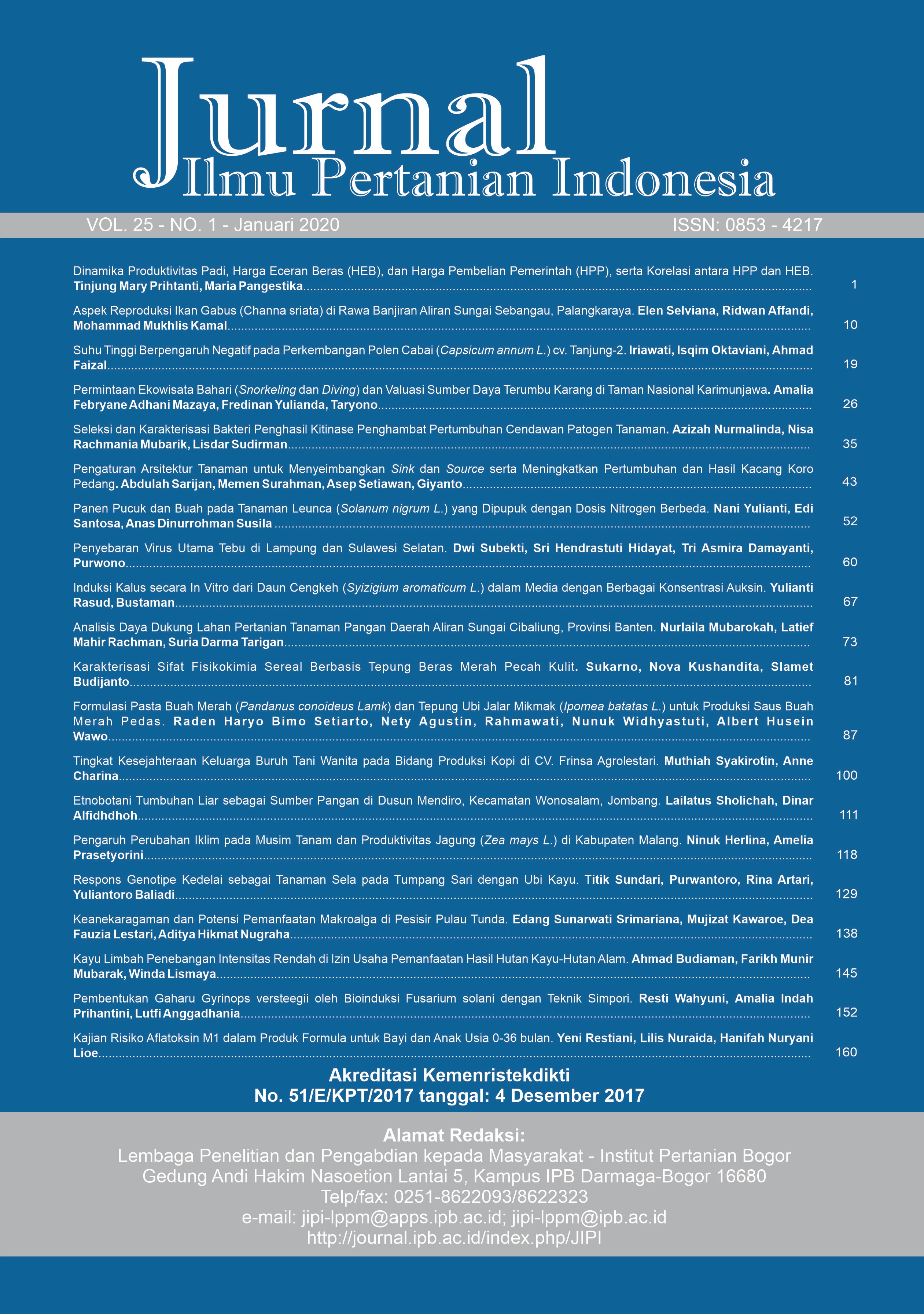Pengaruh Suhu Tinggi terhadap Perkembangan Organ Reproduksi Jantan pada Cabai (Capsicum annum L.) cv. Tanjung-2
Abstract
The development of male reproductive organ in plants is seriously affected by the adverse abiotic stresses. In this study, we investigated pollen development, particularly at microsporogenesis and micro gametogenesis stages of chili pepper (Capsicum annuum) cv. Tanjung-2 upon exposure with high temperature (day/night = 36/33°C). For this objective, anther of different flower sizes ranging from <2.5 mm; 3-4.5 mm; 4.5-7 mm; to 7-11 mm from treated and non-treated plants were collected. The results revealed that the early microsporogenesis stage was highly sensitive to high temperature indicated by a low progression of cells into subsequent process in meiotic division. This result was followed by the inhibition of tetrad formation up to 2%. Consequently, plant produced smaller microscpores and pollens with thin exin that resulted in the decreased pollen viability to 90%. In conclusion, high temperature has negative impact on the development of male reproductive program in chili pepper, including microsporogenesis and micro gametogenesis. Extending approach should be allocated to overcome this problem so that such environmental stress would not decrease the productivity of chili pepper.
Keywords: Capsicum annuum, high temperature, microgametogenesis, microsporogenesis
Downloads
References
Bhandari K, Siddique KHM, Turner NC, Kaur J, Singh S, Agrawal SK, Nayyar H. 2016. Heat stress at reproductive stage disrupts leaf carbohydrate metabolism, impairs reproductive function, and severely reduces seed yield in lentil. Journal of Crop Improvement. 30: 118-151. https://doi.org/10.1080/15427528.2015.1134744
Djanaguiraman M, Perumal R, Jagadish SVK, Ciampitti IA, Welti R, Prasad PVV. 2017. Sensitivity of sorghum pollen and pistil to high‐temperature stress. Plant, Cell & Environment. 1-18. https://doi.org/10.1111/pce.13089
Dwivedi SK, Basu S, Kumar S, Kumar G, Prakash V, Kumar S, Mishra JS, Bhatt BP, Malviya N, Singh GP, Arora A. 2017. Heat stress induced impairment of starch mobilisation regulates pollen viability and grain yield in wheat: study in Eastern Indo-Gangetic Plains. Field Crops Research. 206: 106-114. https://doi.org/10.1016/j.fcr.2017.03.006
Erickson AN, Markhart AH. 2002. Flower developmental stage and organ sensitivity of bell pepper (Capsicum annuum L.) to elevated temperature. Plant, Cell & Environment. 25: 123-130. https://doi.org/10.1046/j.0016-8025.2001. 00807.x
García CC, Guarnieri M, Pacini E, Arroyo J. 2015. Carbohydrate metabolism before and after dehiscence in the recalcitrant pollen of pumpkin (Cucurbita pepo L.). Plant Biology. 17: 734-739. https://doi.org/10.1111/plb.12279
Giorno F, Wolters-Arts M, Mariani C, Rieu I. 2013. Ensuring reproduction at high temperatures. The heat stress response during anther and pollen development. Plants. 2: 489-506. https://doi.org/10.3390/plants2030489
Guo Z, Chen D, Schnurbusch T. 2015. Variance components, heritability and correlation analysis of anther and ovary size during the floral development of bread wheat. Journal of Experimental Botany. 66: 3099-3111. https://doi.org/10.1093/jxb/erv117
Irenaeus T, Mitra SK. 2014. Understanding the pollen and ovule characters and fruit set of fruit crops in relation to temperature and genotype-a review. Journal of Applied Botany and Food Quality. 187: 157-167.
Mason AS, Nelson MN, Yan G, Cowling WA. 2011. Production of viable male unreduced gametes in Brassica interspecific hybrids is genotype specific and stimulated by cold temperatures. BMC Plant Biology. 11: 103. https://doi.org/10.1186/1471-2229-11-103
Mesihovic A, Iannacone R, Firon N, Fragkostefanakis S. 2016. Heat stress regimes for the investigation of pollen thermotolerance in crop plants. Plant Reproduction. 29: 93-105. https://doi.org/10.1007/s00497-016-0281-y
Müller F, Rieu I. 2016. Acclimation to high temperature during pollen development. Plant Reproduction. 29: 107-118. https://doi.org/10.1007/s00497-016-0282 -x
Parra-Vega V, González-García B, Seguí-Simarro JM. 2013. Morphological markers to correlate bud and anther development with microsporogenesis and microgametogenesis in pepper (Capsicum annuum L.). Acta Physiologiae Plantarum. 35: 627-633. https://doi.org/10.1007/s11738-012-1104-x
Paupière M, van Heusden A, Bovy A. 2014. The metabolic basis of pollen thermo-tolerance: perspectives for breeding. Metabolites. 4: 889-920. https://doi.org/10.3390/metabo4040889
Porch TG, Jahn M. 2001. Effects of high‐temperature stress on microsporogenesis in heat‐sensitive and heat‐tolerant genotypes of Phaseolus vulgaris. Plant, Cell & Environment. 24: 723-731. https://doi.org/10.1046/j.1365-3040.2001.00716.x
Putra DP, Dahelmi, Salmah S, Swasti E. 2016. Pollination in chili pepper (Capsicum anniuum L.) by Trigona laeviceps and T. minangkabau (Hymenoptera, Mliponinin). Journal of Entomology and Zoology Studies. 4: 191-194.
Rieu I, Twell D, Firon N. 2017. Pollen development at high temperature: from acclimation to collapse. Plant Physiology. 173: 1967-1976. https://doi.org/ 10.1104/pp.16.01644
Santiago JP, Sharkey TD. 2019. Pollen development at high temperature and role of carbon and nitrogen metabolites. Plant, Cell & Environment. 42: 2759-2775. https://doi.org/10.1111/pce.13576
Sage TL, Bagha S, Lundsgaard-Nielsen V, Branch HA, Sultmanis S, Sage RF. 2015. The effect of high temperature stress on male and female reproduction in plants. Field Crops Research. 182: 30-42. https://doi.org/10.1016/j.fcr.2015.06.011
Sneider JL, Oosterhuis DM. 2011. How does timing, duration, and severity of heat stress influence pollen-pistil interactions in angiosperm?. Plant Signal Behavior. 6: 930-933. https://doi.org/10.4161/psb.6.7.15315
Solankey SS, Singh RK, Baranwal DK, Singh DK. 2015. Genetic expression of tomato for heat and drought stress tolerance: an overview. International Journal of Vegetable Science. 21: 496-515. https://doi.org/10.1080/19315260.2014.902414
Storme ND, Geelen D. 2014. The impact of environmental stress on male reproductive development in plants: biological processes and molecular mechanisms. Plant, Cell & Environment. 37: 1-18. https://doi.org/10.1111/pce.12142
Walbot V, Egger RL. 2016. Pre-meiotic anther development: cell fate specification and differentiation. Annual Review of Plant Biology. 67: 365-395. https://doi.org/10.1146/annurev-arplant-043015-111804
This journal is published under the terms of the Creative Commons Attribution-NonCommercial 4.0 International License. Authors who publish with this journal agree to the following terms: Authors retain copyright and grant the journal right of first publication with the work simultaneously licensed under a Creative Commons Attribution-NonCommercial 4.0 International License. Attribution — You must give appropriate credit, provide a link to the license, and indicate if changes were made. You may do so in any reasonable manner, but not in any way that suggests the licensor endorses you or your use. NonCommercial — You may not use the material for commercial purposes.






















